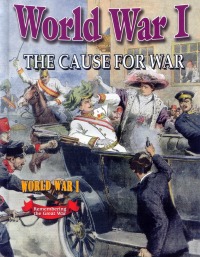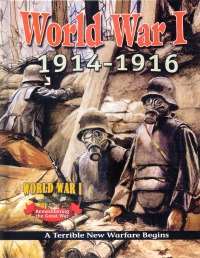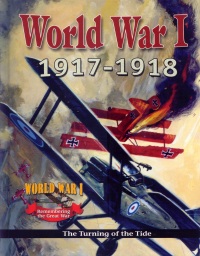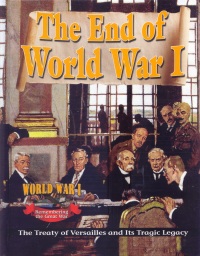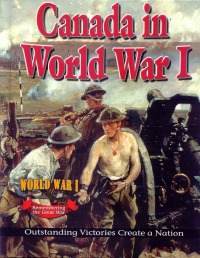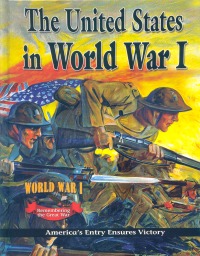| ________________
CM . . . . Volume XXI Number 3 . . . . September 19, 2014
excerpt:
Crabtree's fine six-volume series, "World War I: Remembering the Great War", which covers the events leading up to World War I, the war years, the Canadian and American contributions and the Treaty of Versailles, deserves a place in every middle school library and in classrooms where the war is studied. The series is largely military and political history. Students are introduced to the wartime leaders of each nation, the issues that led to war, the major offences and battles, the commanding generals, the heroes, the changing nature of war and the effects war had on Europe, Canada and the United States. The text is clearly written, the archival photos and contemporary war paintings portray the mood and horror of the war, as well, and the colored maps, glossary and index are more than adequate. The "Further Readings" and "Websites" contain the best and newest histories of the conflict by Margaret MacMillan, Tim Cook, and Sir Max Hastings. There is some selected war fiction; however, more young adult selections would have been helpful. The websites include the BBC's exhaustive The Origins of World War One, the indispensable Library and Archives Canada collections on the First World War and PBS's Milestones, 1914-1920: America's Entry into World War I. "The lamps are going out all over Europe," said Britain's Foreign Secretary Sir Edward Grey, on August 3, 1914, and he prophesied, "we shall not see them lit again in our life." By the time the lamps were re-lit four years later, Europe had utterly changed: a generation of young men had died or been maimed in the mud of Flanders, four once mighty empires had fallen, new powers arose, new nations were born and political and social revolution stalked Europe. Canadian historian Margaret McMillan writes that World War I was the "war that ended the peace." British blood, we learn, had not fallen on European battlefields since the Napoleonic Wars and the continental powers, France, Germany, Austria-Hungary and Russia, had been at relative peace for generations. How and why this cataclysm happened is the subject of World War I: The Cause for War. On June 28, 1914, a young Bosnian-Serb nationalist assassinated Archduke Franz Ferdinand, the heir to the Austro-Hungarian Empire's throne. This event is generally seen by historians as the spark that lit the fuse of the explosive powder keg that Europe had been sitting upon for many years. Students will begin to see the complexity of European power politics and diplomacy. The continent was divided into two armed and distrustful camps: the "Triple Alliance" of the Germany Empire, Austro-Hungarian Empire and the Ottoman Empire versus the "Triple Entente" as the empires of Britain, Russia and France were known. Since the creation of the German Empire, in 1871, Britain, France and Russia feared the new powerful, ambitious, militaristic, industrial state. For its part, Germany feared encirclement by France and the rapidly industrializing Russian Empire. German nationalists believed it was being denied a rightful place as a global power. In turn, France wanted revenge for its humiliating defeat by Germany in 1871; Britain was engaged in a naval race with Germany to build the biggest and fastest warships, and Russia saw itself as the protector of the Slavic people who were ruled by Germany's ally, Austria-Hungary. The powers may not have wanted war at that time, but they were willing to risk war. All the great nations of continental Europe maintained huge standing armies, and the threat of war led Germany and France to develop aggressive war plans as they believed a first strike would lead to victory. The competing alliances "butted heads" in increasingly dangerous crises during the first decade of the twentieth century, but diplomacy had avoided a general conflict. However, the dominos fell with the assassination of Franz Ferdinand and Austria-Hungary's July 28 declaration of war on Serbia. No one would compromise, and country after country declared war on its enemies as the complex alliances demanded. The timetables of the intricate war-plans were followed, and millions of troops moved towards the frontiers and devastation. The war on the western began with the clash of huge French and German armies near the French-Belgium border. A French victory, at the Battle of the Marne River, forced the Germans to retreat and dig defensive trenches. The French and British armies could not break through these trenches, and they dug their own. Much of the war was fought in "no-man's land," the narrow corridor between the entrenched armies. World War I: 1914-1916, A New Terrible Warfare Begins takes students into the stalemate of trench warfare. Generals attempted to defeat the enemy with suicidal frontal attacks involving hundreds of thousands of men. Great battles were fought in the killing fields of Ypres, Verdun and on the Somme River. Machine guns and artillery bombardments slaughtered millions and a new terror weapon, poison gas, was introduced into battle. The focus of the "Great War" is generally on the Western Front. Students will learn that armies of Russia and Germany clashed in the Tannenberg Forest and the Masurian Lakes in Northern Germany, Austro-Hungarians fought Germans in Poland, Serbians and Hungarians fought in the Balkans, a combined army of British, Australian, and Newfoundlanders fought the Turkish soldiers at Gallipoli, armies clashed in Palestine, Africa and Asia. As well, the German U-boat fleet wrecked havoc on shipping, and the British fleet attempted to starve-out the German armies and people by blockading German ports. In World War I: 1917-1918, The Turning of the Tide, we see the war continuing apace. Battles were fought on all fronts; however, the new commanders of the armies introduced new strategies to break the stalemate. The importance of air war increased as fighter aircraft, bombers and zeppelins were added to the combatants' arsenals. At sea, the British continued to blockade Germany and developed ways to combat the U-boat threat. In 1917, the Russian Czar abdicated after the February Revolution; in the fall of 1917, Lenin and his Bolsheviks signed a peace treaty with Germany, much of the French army mutinied and the British army was exhausted. By 1918, French and British armies, supported by Canadian and newly arrived American troops, began the final push against the German lines. With starvation and revolution stirring in Germany, the military commanders of the German high command knew that the war was lost, and an armistice was signed and put into effect on November 11, 1918. When Britain declared war on Germany, Canada was legally obligated to support the "mother country" as students learn in Canada in World War I: Outstanding Victories Create a Nation. In 1914, Canada had a small standing army, but tens of thousands of volunteers, most of whom were of British ancestry or British birth, enthusiastically signed up to join the Canadian Expeditionary Force (CEF). The first troops arrived in England in October 1914 and went into battle in March of 1915. The untested Canadians learned the skills of war as support troops and trench raiders. In April 1915, the Canadians fought at the Second Battle of Ypres where poison gas was used for the first time and where the Canadians suffered over 6000 killed and wounded. Their first offensive role was in the Battle of Kitcheners' Wood and in the First Battle of the Somme where 90% of the men in the 1st Newfoundland Regiment were killed. By the end of 1916, the Canadian army had become an effective fighting force, and in 1917-1918 they were used as "shock troops" in many campaigns. As Marshall Foch, the Commander-in- Chief of the Allied Forces said, "[the Canadian Corps is] the ram with which we will break up the last resistance of the German army." Canadians took a leading role in the pivotal 1918 campaign which was a series of battles known as the Hundred Days Offensive. The Canadians were instrumental in breaking the German line and ending the war. The best-known battle the Canadians fought in was the Battle of Vimy Ridge, April 9-12, 1917. The four divisions of the Canadian Army fought together for the first time, and it was where "Canadian nationality first came together, where all of us were fused or welded, if you like, into a unity." Canada, readers will learn, was changed by the war. The country now had its own heroes. A stronger feeling of national unity existed in the country. Because of its efforts in the war, Canada gained international respect and moved closer to becoming a truly independent nation. However, the war also caused social problems: divisions between English and French Canada were exacerbated by the 1917 Conscription Crisis; there was labor unrest and strikes; western alienation led to the creation of new political parties that challenged the dominance of eastern politicians. The United States did not declare war on the Central Powers until 1917. The U.S. wanted to stay neutral, but, as students will see in The United States in World War I: America's Entry Ensures Victory, there were many conflicting forces that led to the decision to enter the war. The United States was a land of immigrants; however, unlike Canada, many new Americans did not have ties to Britain. Consequently, there was no emotional urge to come to the defense of the "mother land". The American economy was weak, and business wanted to keep trading with both sides in the conflict, but soon most of the trade was with the Allies. Germany retaliated by sinking some American ships, most notably the Lusitania, in 1915, and effective anti-German propaganda caused a wave of sympathy for the Allies. In the famous Zimmerman Telegram, the Germans asked Mexico to join the Central Powers with the inducement being that, after the Central Powers won the war, Mexico would regain the territory it had lost during the Mexican-American War. This act of treachery was the "final straw", and the United States declared war on April 2, 1917. The United States quickly shifted its consumer based economy onto a war footing. Unlike the other volumes in the series, which are almost exclusively military history, this one also provides students with a greater insight on how a modern nation can mobilize its population to meet pressing needs. They learn how the U.S. prepared to fight by implementing conscription, imposing strict rationing, setting up government agencies to raise money and shifting public opinion to "sell the war". The tons of supplies and armaments, along with the eventual four million soldiers of the American Expeditionary Force (AEF), gave the exhausted British and French forces the support they needed to continue on with the war and mount strong offenses. The victorious British and French wanted to blame and punish Germany for the war, and, as students will see in the final volume, The End of World War I: The Treaty of Versailles and Its Tragic Legacy they imposed harsh conditions on their enemy. These conditions damaged the German economy, angered the German people and are seen as casual factors leading to the rise of Hitler and the Second World War. Students will learn how Europe was utterly changed by the war. The map of Europe was redrawn as Germany and Russia gave up territory, the Ottoman and Austro-Hungarian Empires were dissolved and their territories annexed, and the Soviet Union replaced the Russian Empire. Great and horrific technological advances in warfare transformed the way future conflicts would be fought. Industrial power shifted from Europe to the United States as Great Britain's economy was exhausted and the nation was mired in debt. Highly Recommended. Ian Stewart teaches at Cecil Rhodes School in Winnipeg, MB. Copyright © the Manitoba Library Association. Reproduction for personal use is permitted only if this copyright notice is maintained. Any other reproduction is prohibited without permission.
Next Review |
Table of Contents for This Issue
- September 19, 2014. |
